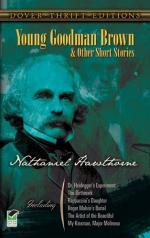|
This section contains 5,646 words (approx. 19 pages at 300 words per page) |

|
SOURCE: "The Problem of Faith in 'Young Goodman Brown'," in JEGP: Journal of English and Germanic Philology, Vol. LXXIV, No. 3, July, 1975, pp. 375-87.
In the following essay, Levy examines Faith as a character, an allegorical figure, and a symbol
Few of Hawthorne's tales have elicited a wider range of interpretations than "Young Goodman Brown." The critics have been victimized by the notorious ambiguity of a tale composed of a mixture of allegory and the psychological analysis of consciousness. Many of them find the key to its meaning in a neurotic predisposition to evil; one goes so far as to compare Goodman Brown to Henry James's governess in The Turn of the Screw [Darrel Abel, in "Black Glove and Pink Ribbon: Hawthorne's Metonymic Symbols," in NEQ 42, 1969]. The psychological aspect is undeniably important, since we cannot be certain whether "Young Goodman Brown" is a dream-allegory that takes place in the...
|
This section contains 5,646 words (approx. 19 pages at 300 words per page) |

|


